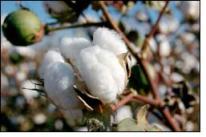Respondents to survey reported a 14 per cent hike to 18,234 acres in US organic cotton acres planted in 2014 from 15,973 acres in 2013, representing the largest planted organic cotton acreage in almost 20 years.

This happened, despite US farmers grappling with tight seed supplies, persistent weeds and a shortage of seasonal labour, a 2013 and preliminary 2014 US Organic Cotton Production & Marketing Trends report, says.
The report published by the Organic Trade Association (OTA) informs that organic cotton acreage has been on a slow but steady growth trend in the US for the past several years.
In 2013, acres planted with organic cotton rose 6 per cent year on year to 14,787, while acres harvested in 2013 fell to 9,262 from 9,842 the previous year.
Laura Batcha, CEO at OTA says, "These latest numbers show the genuine commitment of growers to produce organic cotton and respond to an increasing desire by consumers for organic fibre.
She adds, “Today's consumers want to incorporate organic not just in the food we eat, but in the clothes we wear, the sheets on our bed, and the mattresses on which we sleep."
The OTA report is based on a survey conducted in December of organic cotton growers in Arizona, California, New Mexico, North Carolina and Texas.
The primary concern voiced by organic cotton producers was an effective method of weed control, made even more urgent by the lack of availability of seasonal labour in cotton-growing regions.
“Commercial supplies of organic seed continue to be another major hurdle, with genetically modified seeds now dominating the marketplace, farmers told the surveyors.
US organic cotton growers enjoy a healthy market for their products, and command a premium over non-organic cotton.
Survey respondents reported receiving $1.38 per pound for organic Upland cotton, with prices reaching as high as $2.20 for organic Pima cotton.
The majority of the US organic cotton crop planted in 2013 was upland cotton, with Pima representing fewer than 1,000 planted acres.
Organic fibre is now the largest non-food organic category in the market, with organic fibre sales in the US closing in on $1 billion in 2013.
"Growing organic cotton in the US is a highly specialised and technical discipline and those in the small group of US organic cotton growers are experienced, well-organised and committed,” the OTA report states.
OTA is committed to promoting the growth of the organic cotton industry and the organic fibre sector and a key factor in that growth is consumer trust in the organic label.
To that end, OTA is working with government officials to develop an enforcement policy on the use of organic claims on textiles.
It is also member of Global Organic Textile Standard (GOTS), the standard for organic fibres established in the early 2000s to give consumers assurance of the validity of the organic claim.





